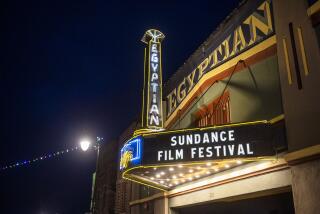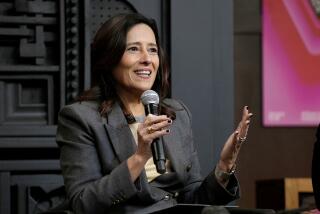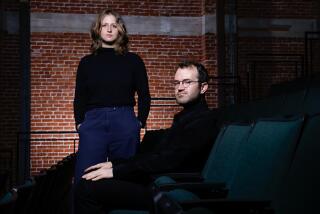New Frontier exhibition at Sundance focuses on the future

Sitting at her desk in a darkened office, Shari Frilot picks up a boxy piece of cardboard fitted with two bulbous glass lenses. She lifts a crude cardboard flap and inserts her smartphone in front of the lenses, securing it in place with Velcro. This new virtual-reality system is called Google Cardboard. It sells for about $20, but 8,000 of them will be given out at the Sundance Film Festival this year so that guests can experience three art installations.
Sundance may be best known as the place to discover top independent films, but the festival’s New Frontier exhibition curated by Frilot has cultivated its own reputation, emerging as the go-to source for the kind of cutting-edge cinematic innovations found at the crossroads of art, filmmaking and multimedia technology.
This year, an interactive hybrid of documentary film and video game takes viewers to the streets of Tehran during the 1979 Iranian revolution. A virtual-reality installation called Birdly invites you to strap into a simulator, flap your wings and soar to points unknown. One large-scale projection ushers viewers through interactive urban and natural spaces augmented by real-time astrological and meteorological data, and another work presents the story of a romantic break-up that splinters into parallel lovers’ journeys, with viewers choosing different paths.
Championed by Sundance founder Robert Redford, the New Frontier exhibition features 15 multimedia works by 13 artists who explode the boundaries of traditional storytelling and gaming design, creating immersive environments that often place the viewer inside the story and sometimes inside the frame. These works belong at Sundance because they are harbingers of the future, says Redford, who believes that a new storytelling medium is being born and that these artists are leading the charge.
“Using new technologies, artists are evolving how stories are told — through games, virtual reality, playing with perception and putting the audiences right in the piece,” Redford said recently by email. “New Frontier reflects the spirit of this experimentation at its best.”
Frilot elaborates while walking through the hallways of the Sundance Institute on Wilshire Boulevard in Los Angeles.
“When you bring together creative minds from different fields, they start talking to each other and creating something that is larger than the sum of its parts,” she says. “Instead of going into a black box and watching a film, we treat our space as a fully immersive cinematic environment and place these works inside.”
Frilot has worked for Sundance since 1998, having gotten her start in the early ‘90s founding an experimental gay and lesbian film festival in New York called MIX. She went on to co-found MIX Brazil and MIX Mexico before coming to L.A., where she went to work for Outfest and then Sundance. She was a good fit for New Frontier’s mission thanks to her early work exhibiting the digital video installation “Cyberqueer” at the 1994 MIX festival. Although these days, virtual reality makes that work look quaint.
One of the medium’s leading pioneers, Palmer Luckey, who founded the virtual reality start-up Oculus VR, made his cinematic debut at New Frontier in 2012 after creating a beta VR headset for an installation by journalist-turned-virtual-reality news documentarian Nonny de la Peña. The piece, which transported viewers to a bread line for the hungry on the streets of Los Angeles, was so well received that Luckey launched a Kickstarter campaign to make a consumer headset called Oculus Rift. He set his goal at $250,000 and raised $2.5 million.
Oculus Rift cracked open the VR world and others rushed in, including Google Cardboard.
The works that will be shown on Cardboard this year are apps by Chris Milk, Ian Hunter and De la Peña. The work was designed to be downloaded, a way of democratizing the VR space. Last year Milk had a New Frontier installation that played on Oculus Rift. The nine-minute piece played at a single viewing station, so the curious had to wait in long lines to experience it.
“It wasn’t that scalable of an experience,” says Milk, whose current piece, “The Evolution of Verse,” takes viewers on a journey through a series of beginnings, featuring the poetic movement of birds and a variety of natural abstractions — images that flow one into the other.
“The potential Google Cardboard offers is massive,” he says. “It makes the medium affordable, and it can now be distributed on a mass scale. You don’t watch an awesome movie at Sundance and leave with a DVD you can share with your friends, but in this instance that’s just what we’re doing. It’s beautiful. Your film is a dandelion blown out the door and into the world and where those seeds land, who knows.”
In this case, the seeds are landing at the feet of some of film’s most powerful players and cross-pollinating with their high-profile projects.
Inspired in part by New Frontier, Fox recently launched the Fox Innovation Lab, which employs resident “Fox Futurist” Ted Schilowitz and focuses on the possibilities of these new technologies. It is the first major film studio to have an installation at New Frontier.
Called “Wild: The Experience” and created by VR artists Félix Lajeunesse and Paul Raphaël (known as Felix & Paul), the three-minute piece is viewed through a system called Samsung Gear VR, which is powered by Oculus. Viewers are brought inside the woods on the Pacific Crest Trail with Reese Witherspoon and Laura Dern, who star in the new Fox film “Wild.” The piece is not an excerpt of the film; it is a stand-alone work of art. Look in one direction to watch Witherspoon, another to watch Dern and another simply to gaze at the softly blowing trees.
Schilowitz and two other Fox executives who partner with him in the Innovation Lab said in a recent interview that the studio has its sights set on creating “complementary artistic experiences” for movies the studio puts out.
“We are trying to come up with an idea for ‘The Martian’ with Ridley Scott,” says Ted Gagliano, Fox’s president of post production. “We think the idea of a VR experience where you’re there with Matt Damon being left behind on Mars could be extraordinary. Can the technology pull it off? That’s what we don’t know yet.”
David Greenbaum, senior vice president of production at Fox Searchlight, adds: “VR experiments were showing up at New Frontier a few years ago, but they were incredibly fringe. They certainly weren’t considered the go-to event. I believe the New Frontier section is going to be one of the most exciting places at Sundance this year.”
The give and take between artists and filmmakers at New Frontier works both ways, curator Frilot says. It’s a point best illustrated by multimedia artist Doug Aitken, who after exhibiting an installation at New Frontier last year is now screening a film called “Station to Station” in the New Frontier film category, which is separate from the art installation category. In crossing over to experimental film, Aitken has created a documentary made of 60 one-minute films about a journey taken via train by artists and musicians performing at specific stops across the country.
“No longer is film the only tool of the moving image. We have this myriad of other devices and techniques that have opened up the idea of narrative,” Aitken says. “We are now hit by so many different angles of information, but we’re just people. How do we handle this? How do we sculpt it into something with human qualities? What is happening is a revolution.”
Twitter: @jessicagelt
More to Read
Only good movies
Get the Indie Focus newsletter, Mark Olsen's weekly guide to the world of cinema.
You may occasionally receive promotional content from the Los Angeles Times.







